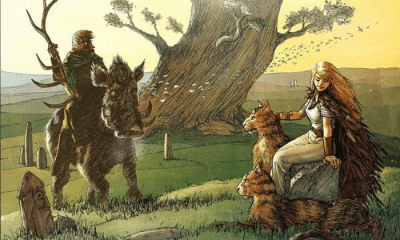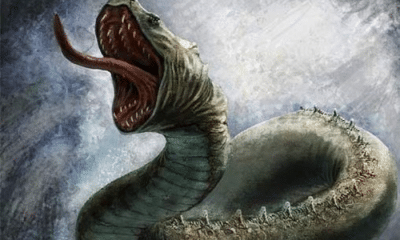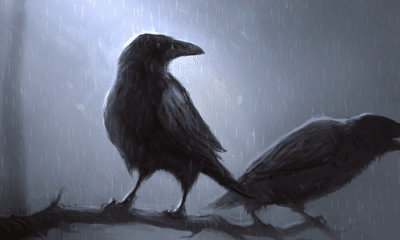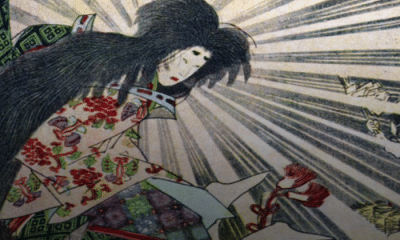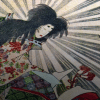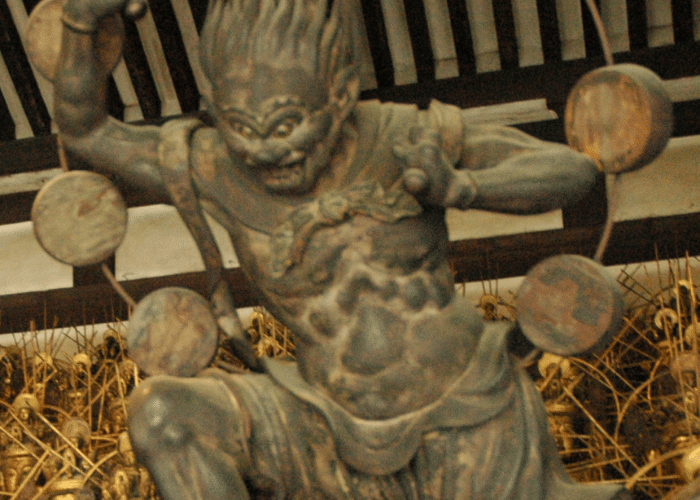
Japanese
Raijin: The Thunder God of Japan
Raijin: The Thunder God of Japan
He may look menacing, but the thunder god Raijin was also one of Japan’s greatest benefactors. Keep reading to learn how the threatening storm god also saved the country from possible ruin!
In Japanese religion, the world is full of kami. These god-like spirits inhabit everything in the natural world.
Many of the kami are minor spirits, but some have the power to influence the entire nation. One of these is the thunder god Raijin.
In a country prone to extreme weather, the god of storms could be a terrifying figure. Throughout its history, the people of Japan have been at Raijin’s mercy when he sends kamikaze typhoons and the destruction they bring.
The thunder god was not entirely malevolent, however. As much as his storms could threaten Japan, they also brought needed rain.
In one memorable case, Raijin’s power even saved the country. Sudden storms drove off the greatest enemy the Japanese people had ever faced on two separate occasions.
The Appearance of Raijin
In his appearance, Raijin is one of Japanese culture’s most terrifying gods.
He has a muscular body which is emphasized by the fact that he wears only a simple pair of pants rather than more formal robes.
His hair seems to defy gravity. It stands up around his head in wild spikes.
Most terrifying, however, is the expression on Raijin’s face. His face is twisted in a large, sinister-looking grin that is emphasized by severe eyebrows and pointed teeth.
Often, his terrifying appearance includes a pig-like nose, horns, or pointed years. Raijin appears wholly inhuman, in contrast to many more benevolent deities in Japanese art.
Raijin usually holds hammers which he uses to beat on large Taiko drums. The sound of this percussion makes the booming thunder that accompanies his bolts of lightning.
Often, these drums have the symbol of a tomoe. This comma-like swirl was used in sacred images and jewelry as early as the Bronze Age.
Raijin and his drums are often carried atop billowing clouds. In some images he peers over the side of the clouds as he beats with his hammers.
In appearance, Raijin appears to be an Oni rather than a god. The Oni were malevolent demons who were focused only on destruction and terror.
Raijin, however, is typically shown with one attribute that proves his divinity.
In the tradition of divine figures in Buddhism, Raijin is usually shown within a halo. While Buddhist halos typically surround only the person’s had, Raijin’s goes around his entire body.
Raijin’s halo is marked by plates that sometimes feature religious imagery from the many traditions that influenced Japanese folklore. Shinto, Buddhist, and Taoist symbols surround the evil-looking god to emphasize his divinity.
Raijin’s appearance makes clear what is shown in his myths and legends: He is a holy figure, but one that is to be feared and respected.
A Frightening But Helpful God
The god of thunder and lightning was particularly important on the islands of Japan.
Japan’s location and geography make it prone to extreme and unpredictable weather. Sudden storms and strong typhoons have always posed risks to the island nation’s residents, particularly in the ancient past when storms, landslides, and floods were less predictable.
It seems obvious, therefore, that the god of such storms would be one of the culture’s most powerful and fearsome deities. In parts of Japan there are still superstitions that involve pacifying Raijin during thunderstorms to avert disaster.
Despite this, however, Raijin was not an entirely destructive or malevolent figure.
While strong storms could cause massive damage, rain was still essential to agriculture. Because of this, Raijin was often welcomed by farmers and people prayed to the fearsome god to end droughts.
In fact, the Japanese believed that lightning could bring a more plentiful harvest. Rice that had been struck by lightning was thought to be more fertile and lead to a bountiful food supply.
In some stories, Raijin is shown as mischievous rather than malicious. When the Emperor asked him to stop his destructive habits he simply laughed, obeying only when ordered by a Buddhist bodhisattva.
Raijin’s mischievous nature can be attributed to the unpredictability of lightning and storms. In mythology, however, his evil-looking face and disobedience are also reflective of his link to the Underworld.
The Birth of Raijin
Raijin was one of the children of the creator deities Izanagi and Izanami. He was not only their last child, but was also born after his mother’s death.
Izanagi had been fatally injured when giving birth to the fire god Kagutsutchi. She died from her burns and descended to Yomi no Kuni, the Underworld.
Her husband, Izanami, was heartbroken over his wife’s death. He followed her to Yomi no Kuni in an attempt to bring her back.
Once in the Underworld, however, Izanagi could not leave again. She went to her palace to negotiate with the kami of Yomi and try to win her freedom.
Izanagi had told her husband to wait for her, but he began to grow impatient. After waiting for several hours, Izanami lit a small fire on the tip of his comb to find his way and followed Izanagi’s trail through the Underworld.
When he found Izanagi inside her palace, he was horrified at what he saw. She had failed to convince the kami to let her live and was already decaying.
Maggots were swarming, and she was rotting, and in her head dwelt the Great-Thunder, in her breast dwelt the Fire-Thunder, in her left hand dwelt the Young-Thunder, in her right hand dwelt the Earth-Thunder, in her left foot dwelt the Rumbling-Thunder, in her right foot dwelt the Couchant-Thunder — altogether eight Thunder-deities had been born and dwelt there. Hereupon His Augustness the Male-Who-Invites [Izanami], overawed at the sight, fled back…
-The Koj-Iki (trans Chamberlain)
Eight aspects of Raijin, the eight types of thunder, had been born from Izanagi’s corpse.
When Isnami fled from the sight of his wife’s body she sent Raijin and several female Oni to chase him through Yomi no Kuni.
He threw the vine that secured his hair knot to the ground and it turned to grapes and bamboo shoots. Many of the Oni were distracted by the food, allowing him to reach the upper level of Yomi.
Once there he picked peaches off a nearby tree to throw at the remaining Oni. He then declared peaches sacred and ordered that they should grow n the land of the living to help the people there as they had helped him.
Realizing that Izanami was about to leave Yomi forever, Izanagi herself began to pursue him. He had shamed her by seeing her rotting form and she was driven nearly mad in her rage.
Izanami returned to the surface, however, and blocked the entrance to Yomi no Kuni with a boulder. Izanagi swore that she would kill a thousand people each day for his crime, but Izanami vowed to create a thousand plus five hundred to thwart her.
Raijin was therefore tied to the Underworld. His form in many ways reflected his closeness to the Oni even if he was not necessarily one of them himself.
Names of the Kami
Raijin was born in eight forms, each of which reflected an aspect of his whole.
Together the eight minor kami of thunder created a single powerful entity. His name, Raijin, is simply written with the characters for “thunder” and “god.”
Like many gods, Raijin went by other names in some works. Because his name was so simply descriptive, many alternatives allowed for a similar meaning to be given.
These alternative names included:
- Kaminari-sama: Lord of Thunder
- Raiden-sama: Lord of Thunder and Lightning
- Narukami: The Resounding God
- Yakusa no ikazuchi no kami: God of Storms and Disaster
- Ho-no-Ikadzuchi-no-Kami: A name for the combined eight gods born in Yomi.
These names generally refer to Raijin’s power and propensity for destruction, but his imagery more often shows his protective aspect. The very fact that he was so destructive gave Raijin credit for saving Japan from one of the greatest threats it faced in its history.
Raijin and the Failed Invasion
In the 13th century, Kublai Khan and his Mongol army had conquered much of East Asia. He established the Yuan Dynasty after taking control of China’s capital and had made Korea a vassal state after a series of brutal invasions.
Japan at the time was ruled by the Emperor in name only. True power was held by the shogunate regents of the Hōjō clan, who were so powerful that they no longer bothered to consult the other shoguns when they made decisions.
Kublai Khan sent a letter to these military rulers. He asked Japan to willingly become a vassal state of his great Mongol Empire or, like much of mainland Asia, he would stage a violent invasion.
The shoguns orders those who lived in Kyushu, the area closest to Korea and thus the most likely to be attacked, to prepare for war. The Imperial Court suggested a compromise with the Khan but had too little power to push their agenda.
On November 5th 1274, the Mongols invaded the small island of Tsushima, halfway between Kyushu and the Korean peninsula. The fleet was spotted in time for local leaders to mount a defense, but they quickly fell to the Mongol archers.
On the 13th they attacked Iki Island, once again quickly overwhelming the samurai who defended it. One man who was able to escape fled to Kyushu to report the Mongol advancement.
When the Mongols reached Hakata Bay on the 19th the Japanese defenders had been able to prepare thanks to the report from Iki Island. It quickly became clear, however, that they were no match for Kublai Khan’s warriors.
The surviving Japanese defenders were pushed back to an ancient earth fort where they were prepared to make their last stand. When the sun rose the next morning, however, their enemy had disappeared.
A sudden wind had arisen during the night and pushed the Mongol fleet back out to sea. According to Yuan historians, a massive storm then destroyed several ships, killing nearly half of their forces.
The Japanese knew that the Mongols would return, however, and began strengthening their defenses. When emissaries arrived the next year demanding a response, the shoguns sent their heads back to the Khan. Four years later, the response was the same.
In June of 1281, the Mongols again attacked and conquered Tsushima and Iki. They again advanced to Hakata Bay, but this time they were held off with new stone walls.
The Japanese not only held off the Mongol invaders but were able to repel them. For a month they led daring raids on board the enemy ships, pushing the invaders back until they had lost Iki Island.
By August, however, the Mongols had adapted to these techniques. The small Japanese boats were no longer able to harass the larger ships and the invaders again advanced to the bay.
On August 15th the Mongol ships were at anchor just off the Japanese coast when the weather again turned against them. A massive typhoon, called a kamikaze in Japanese, hit the coast and devastated the Mongol fleet.
Up to 90% of the invading force was destroyed in a single day. Surviving ships abandoned those that had wrecked, leaving thousands of men to die in the water or be rounded up by the Japanese.
According to an eyewitness account, over 100,000 Mongols, Northern Chinese, and Korean fighters were killed either in the storm or when they washed ashore and were found by the vengeful Japanese.
The Mongols lost most of their naval power in the kamikaze. Both they and later Chinese dynasties remembered the event and refused to risk invading Japan again.
Japan, meanwhile, had reason to believe that it had been saved by its gods. In the face of two Mongol invasions, they had been saved not by their own fighting power but by sudden strong storms.
Raijin, the god of thunder, was given much of the credit. The threatening god was seen almost immediately as Japan’s protector.
Raijin’s status as a protective god can be seen literally in his most famous image at the Buddhist Sanjusangendo Temple in Kyoto. The lacquered wooden statues of the thunder god and his brother Fujin, the god of wind, are the temple’s protectors and are listed among Japan’s greatest national treasures.
His Brother and Other Companions
Sanjusangendo Temple is not the only place where Raijin is closely aligned with his brother.
The two gods were natural partners. Wind and thunder often accompanied one another either as destructive forces or, in the case of the Mongol invasions, to protect.
As protective gods, Raijin and Fujin often ride on clouds on either side of a doorway or shrine. In other contexts, however, they did not appear to work together as well.
In less formal scenes, the brothers are sometimes shown fighting one another. In folklore, storms arise when Raijin and Fujin dual for supremacy of the sky.
Because they are so closely linked, Raijin and Fujin often share their temples as well. The people of Japan believed that they had to pray to both of the kami to prevent disastrous storms while still bringing the rain they needed.
The two are often pictured with other kami, as well.
Occasionally, they are linked to another brother, Kuraokami. As the god of snow, however, he was usually shown with Fujin rather than Raijin.
Raijin also had a son named Raitaro. According to one story, Raitaro had been fostered by a peasant family and brought prosperity to their modest farm before rejoining his father.
He is also seen with Raiju, the thunder beast.
Raiju is a blue and white creature made of lightning. He often takes the form of a dog or wolf, but can also appear as a weasel, fox, dragon, bear, or other animal.
Raijin’s animal companion is usually docile but becomes agitated in storms. When Raijin makes thunder, Raiju begins to frantically jump around trees, fields, and buildings.
Trees that have been struck by lightning are said to have been scratched by Raiju.
The beast even attacks people. It is said that he sleeps in people’s navels at night, so when a storm hits he will wake them by biting at their stomachs. Superstitious people sleep on their stomachs during storms.
The Power of Raijin
Raijin, the god of thunder, is a powerful figure in Japanese mythology.
He was born to the creator goddess, Izanagi, after her death. This gave him a complicated personality and imagery as he was fully divine but born to a vengeful spirit in the Underworld.
Raijin’s threatening nature can be easily seen in his imagery. His face is twisted in a sinister grin with sharp teeth.
He makes thunder by banging on his drums with hammers. He has a muscular, powerful-looking figure.
He is usually pictured alongside his brother Fujin, the wind god, who is similarly monstrous-looking. His animal companion is a shapeshifting beast made of lighting called Raiju.
Despite these features, which are more common among demons than gods, Raijin also has marks of divinity. He is surrounded by a Buddhist-style halo and ancient religious symbols.
Often, he is shown as a character that is mischievous rather than malevolent. He obeys no one but the bodhisattvas and is unpredictable.
He can also be a helpful god, however. His storms break droughts and, according to popular belief in the past, rice that was struck by lightning was more fertile.
The people of Japan also believed that he protected their entire nation from one of the most serious threats it faced in its history. Attempted invasions by Kublai Khan’s mighty Mongol army were thwarted by the god’s powers, first with a rogue wind that blew the Mongol fleet to sea and years later by a typhoon that destroyed most of their naval power.
Raijin is a complicated figure in Japanese folklore, but there is no doubt that he is a powerful one.
Whether as the menacing god who can send lightning strikes and floods or the protector of the nation, the people of Japan had good reason to venerate and respect the power of their thunder god.


